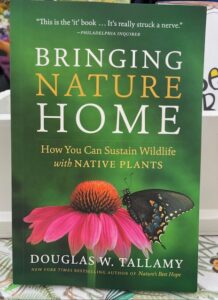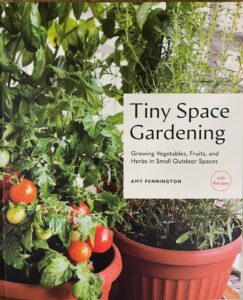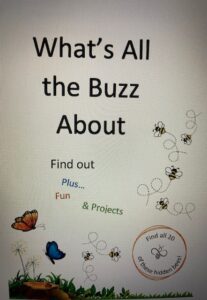Books
There are lots of great books out there for adults and children on pollinators, habitat health, planting a native garden, and more. Check out our list below and then visit your library or bookstore.
The Xerces Society co-authors many books about pollinators. Attracting Native Pollinators is an excellent guide to conserving bees and butterflies and their habitats. More book selections from Xerces can be found on their website.
The Bee Friendly Garden by Kate Frey and Gretchen LeBuhn. Everything you need to know to create a dazzling garden that helps both the threatened honeybee and our own native bees. From an award-winning garden designer and a bee expert.
Bringing Nature Home by Doug Tallamy describes the positive effects to our environment of growing plants native to your region, and how even small changes can be beneficial.
Pacific Northwest Insects by Merrill A. Peterson is a great resource for identifying the insects of the Pacific Northwest. Filled with vivid photographs and information on more than 3,000 insect species.
100 Plants to Feed the Bees, another offering from the Xerces Society, is a user-friendly field guide that shows what you can do to help protect our pollinators.
Finding the Mother Tree: Discovering the Wisdom of the Forest by Suzanne Simard. Relates the author’s discovery of forests as interdependent societies with the mother tree at the center of the community. A moving narrative by one of the world’s leading forest ecologists.
Tiny Space Gardening by Amy Pennington. No matter how small your gardening space, you can plant delicious and healthy vegetables to cook at home. Includes recipes for delicious fresh meals.
Complete Container Herb Gardening by award winner garden designer, writer and speaker Sue Goetz. Everything you need to know to create an herb garden on your patio, balcony, urban rooftop, or any small space.
The Pollinator Victory Garden by Kim Eierman. Win the war on pollinator decline with ecological gardening. Use this book to create a pollinator paradise and learn how to save bees, butterflies, beetles and bats.
Grow Your Soil by Diane Miessler. An entertaining and approachable primer on soil-based gardening. Includes basic background science and practical steps for those new to soil nurturing.
From Wasteland to Wonder by Basil Camu. Discover ways to help heal the damage done to urban landscapes.
In 50 Ways to Help Save the Bees by Sally Coulthard, the author points out that the very species that relies on bees for their survival (humans) is also destroying them. She has suggestions and easy instructions on the little things we can all do to make a big impact.
The Bees in Your Backyard by Joseph S. Wilson and Olivia Messenger Carill. A fascinating introduction to the roughly 4,000 different bee species found in the United States and Canada. Learn about their history, where they live, how they gather food, and their important role as pollinators.
Nature’s Action Guide by Sarah F. Jayne. The best remedy for feeling discouraged about what’s happening to our environment is to take action. This book offers a list of actions with step-by-step instructions to help you transform your yard into a thriving, biodiverse habitat.
In Bea’s Bees by Katherine Pryor and illustrated by Ellie Peterson, a young girl named Beatrix discovers a bumblebee nest on her way home from school. This begins her adventure in rescuing the nest and learning all the fascinating facts about bees and how they make the world go around. This is a wonderful resource for children.
Also by Doug Tallamy, the young reader’s version of his book, Nature’s Best Hope. Aimed at middle schoolers, Tallamy encourages kids to get out in their back yards and create gardens that benefit the environment. He breaks down the science of climate change and info on pollinators into simple terms and shows how everyone can do their part.




Teaching Tools

This engaging Pollinator Elementary Curriculum workbook was designed by a high school student as part of her Girl Scout project. She was awarded the Gold Award, the highest achievement in the Girl Scouts.
This booklet is a wonderful teaching tool for young people. The author explains the steps involved in pollination and the importance of protecting pollinators using illustrations, puzzles and games. Available to print or download.
This booklet is a wonderful teaching tool for young people. The author explains the steps involved in pollination and the importance of protecting pollinators using illustrations, puzzles and games. Available to print or download.
